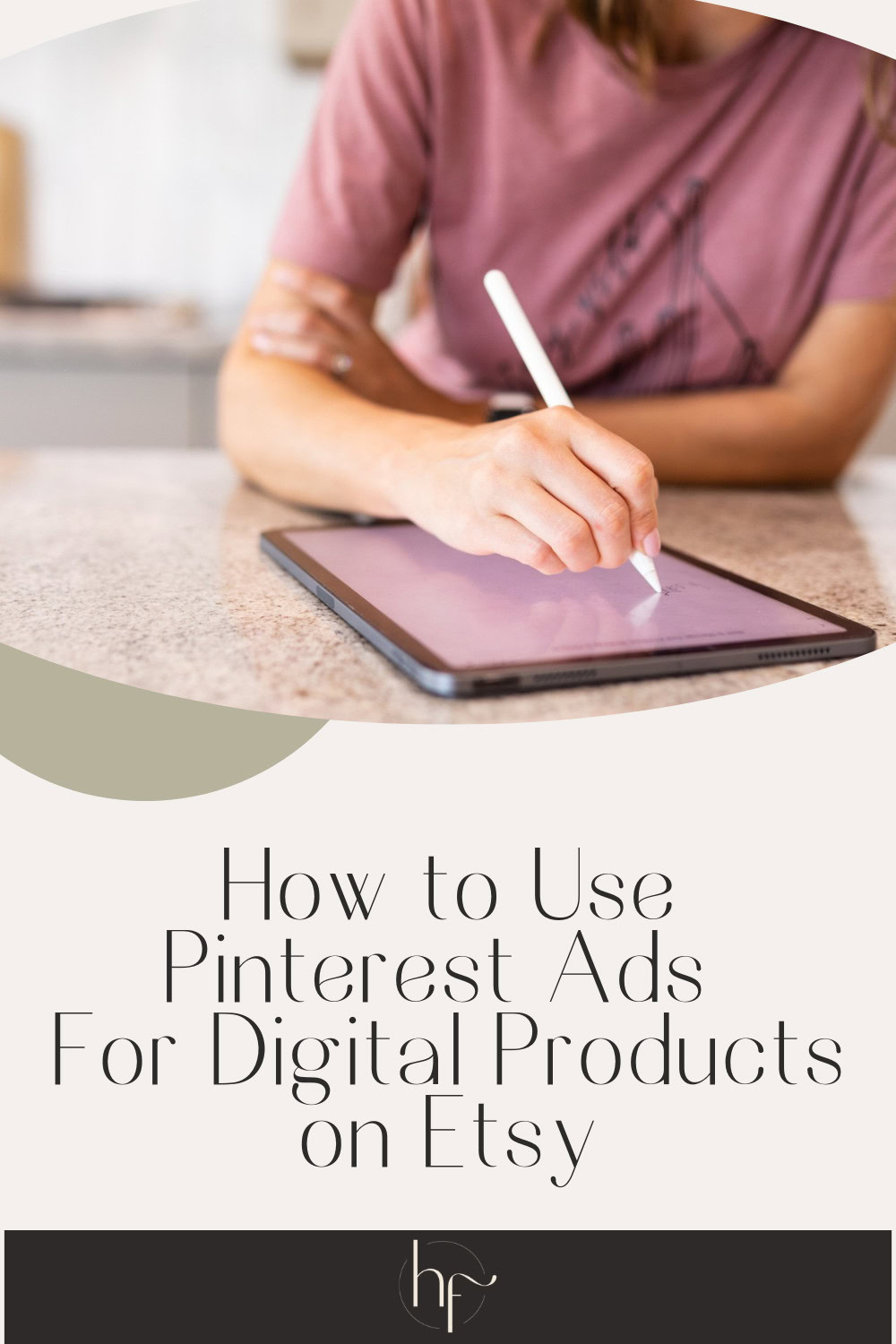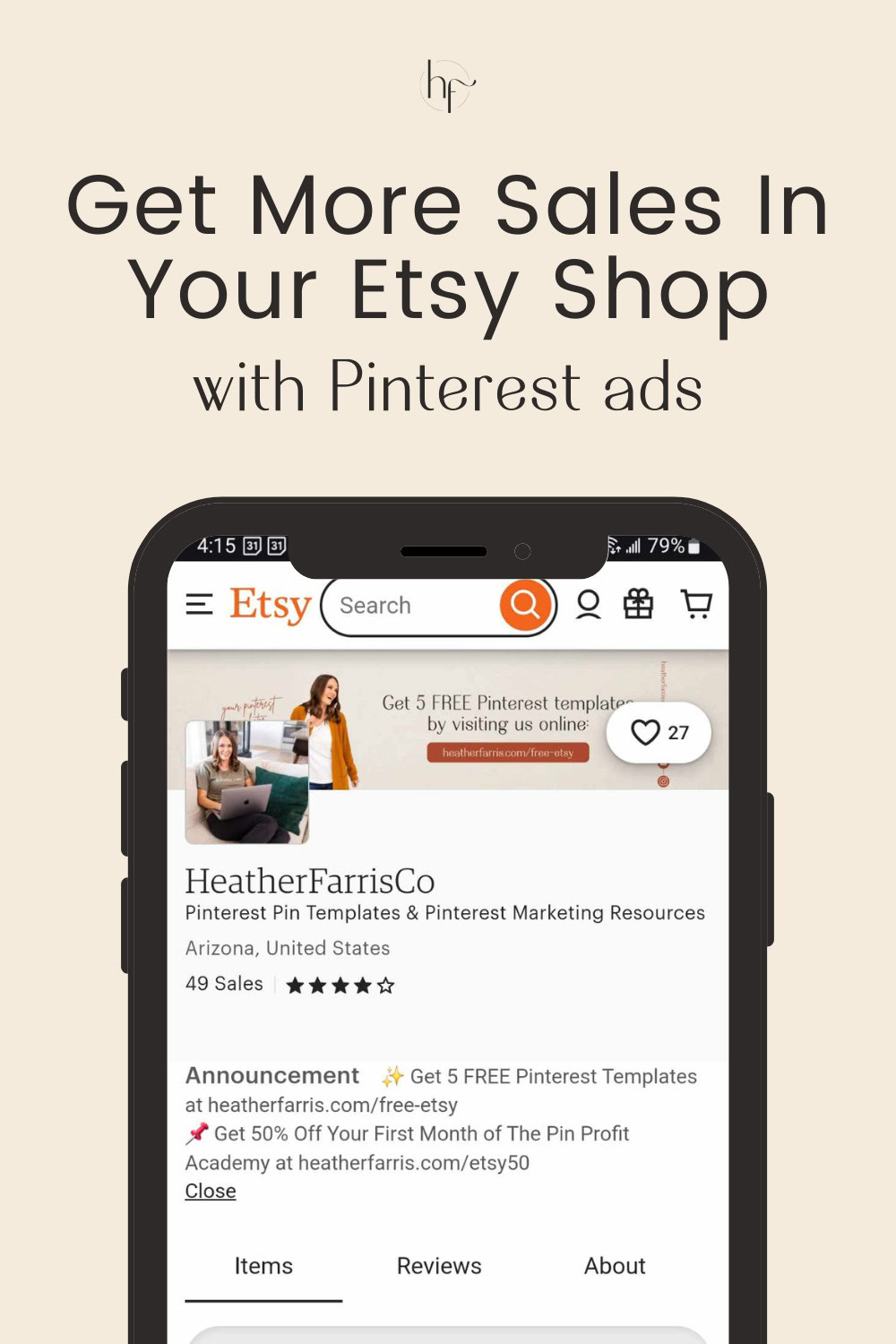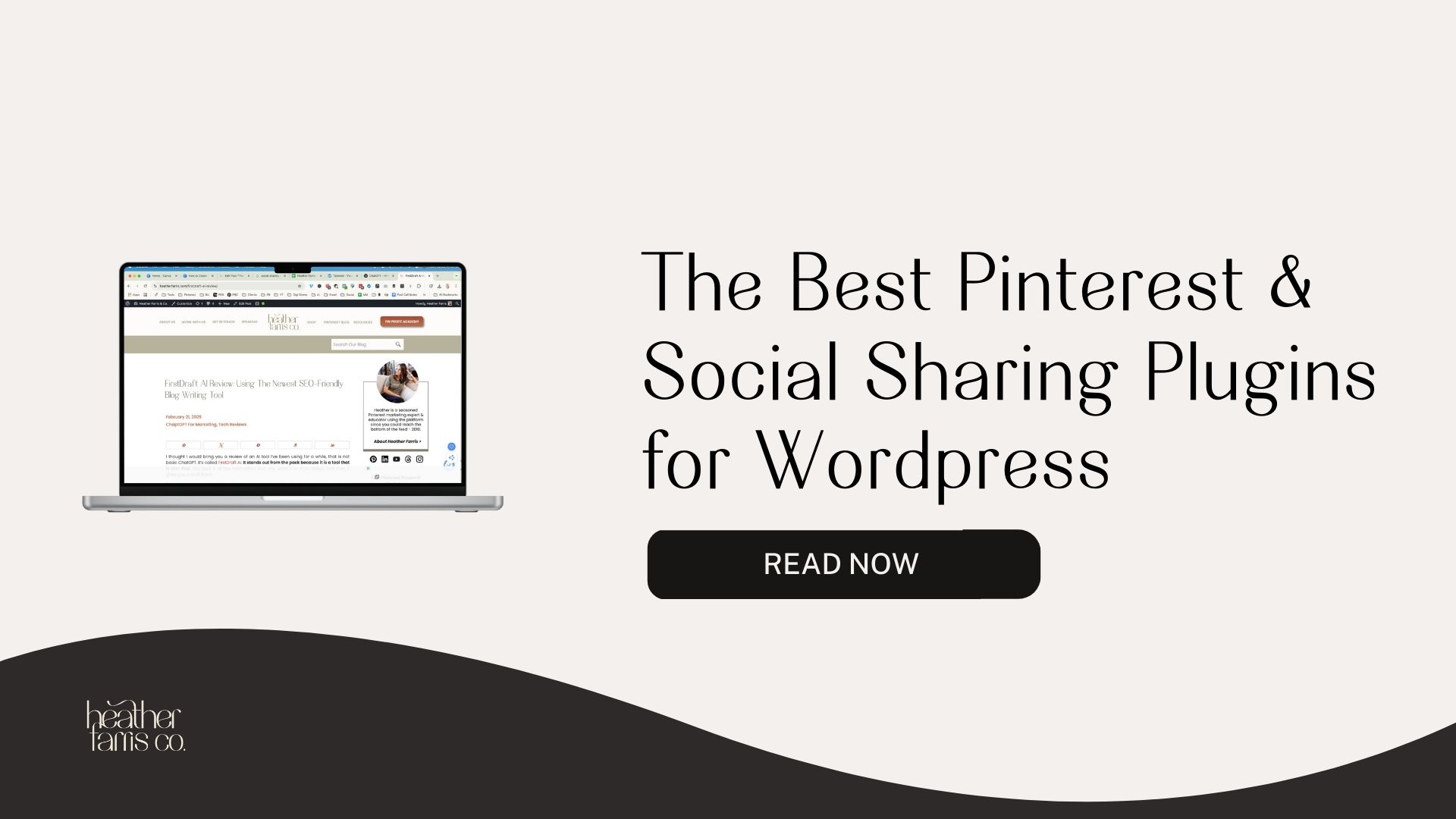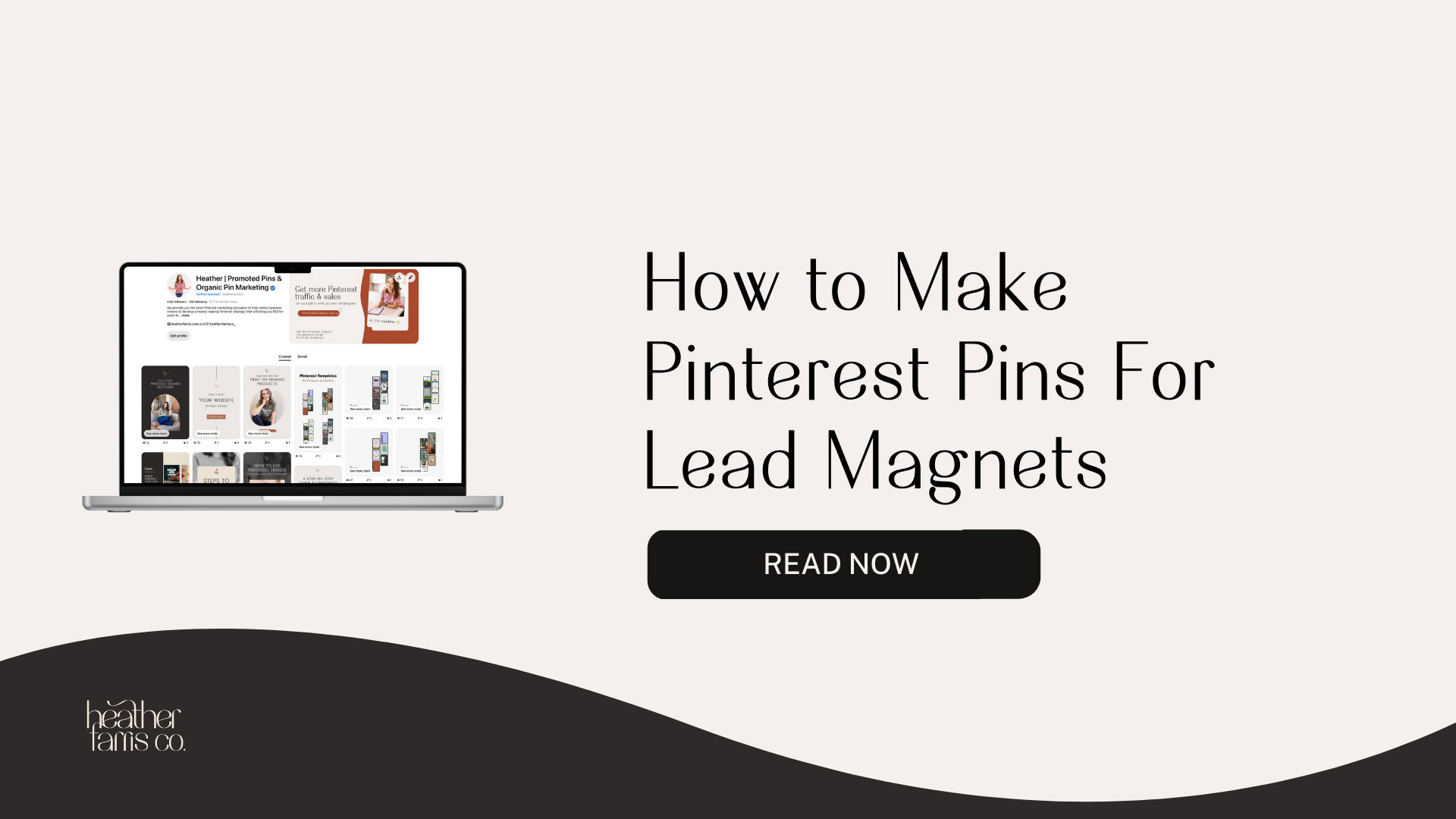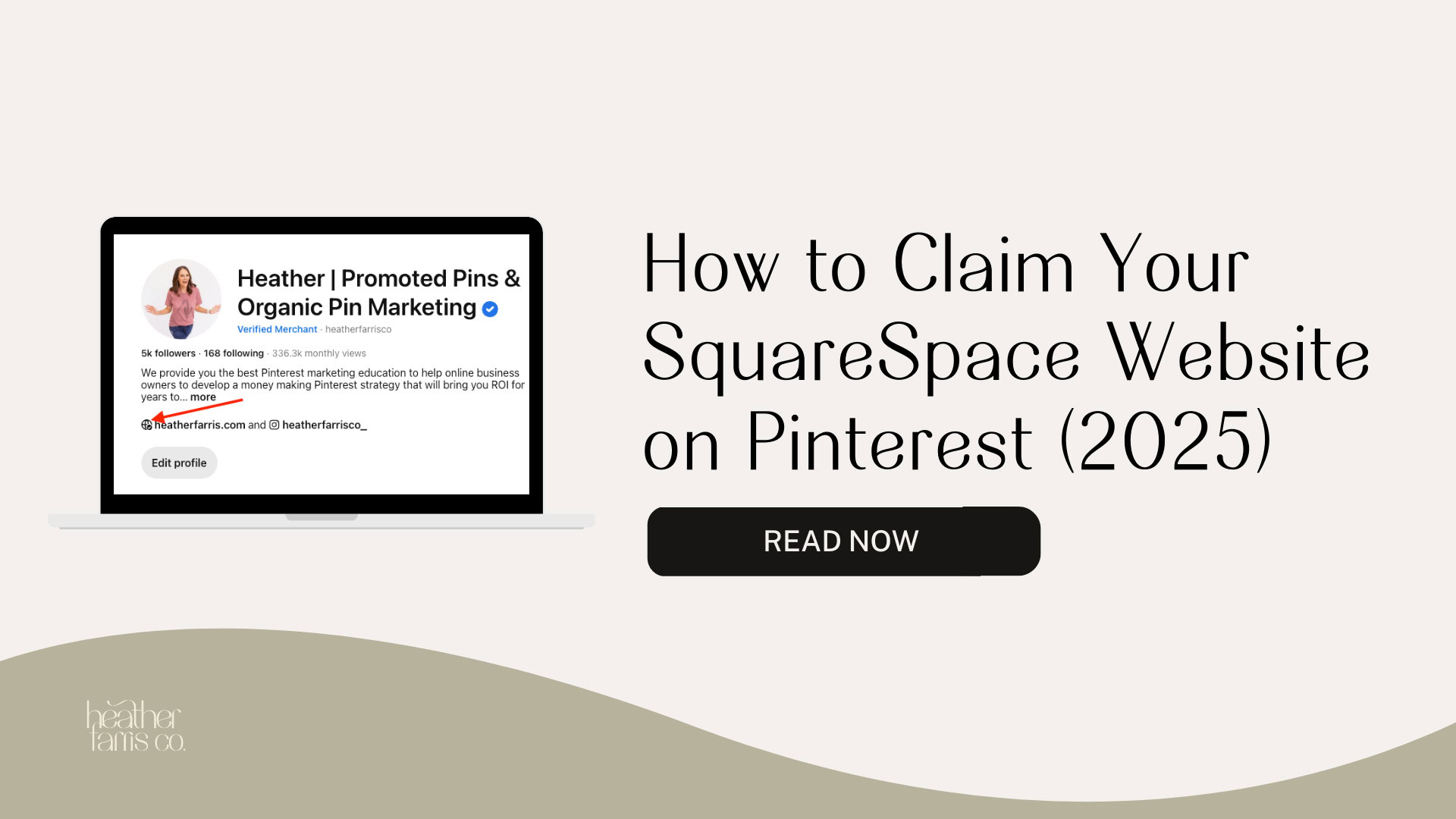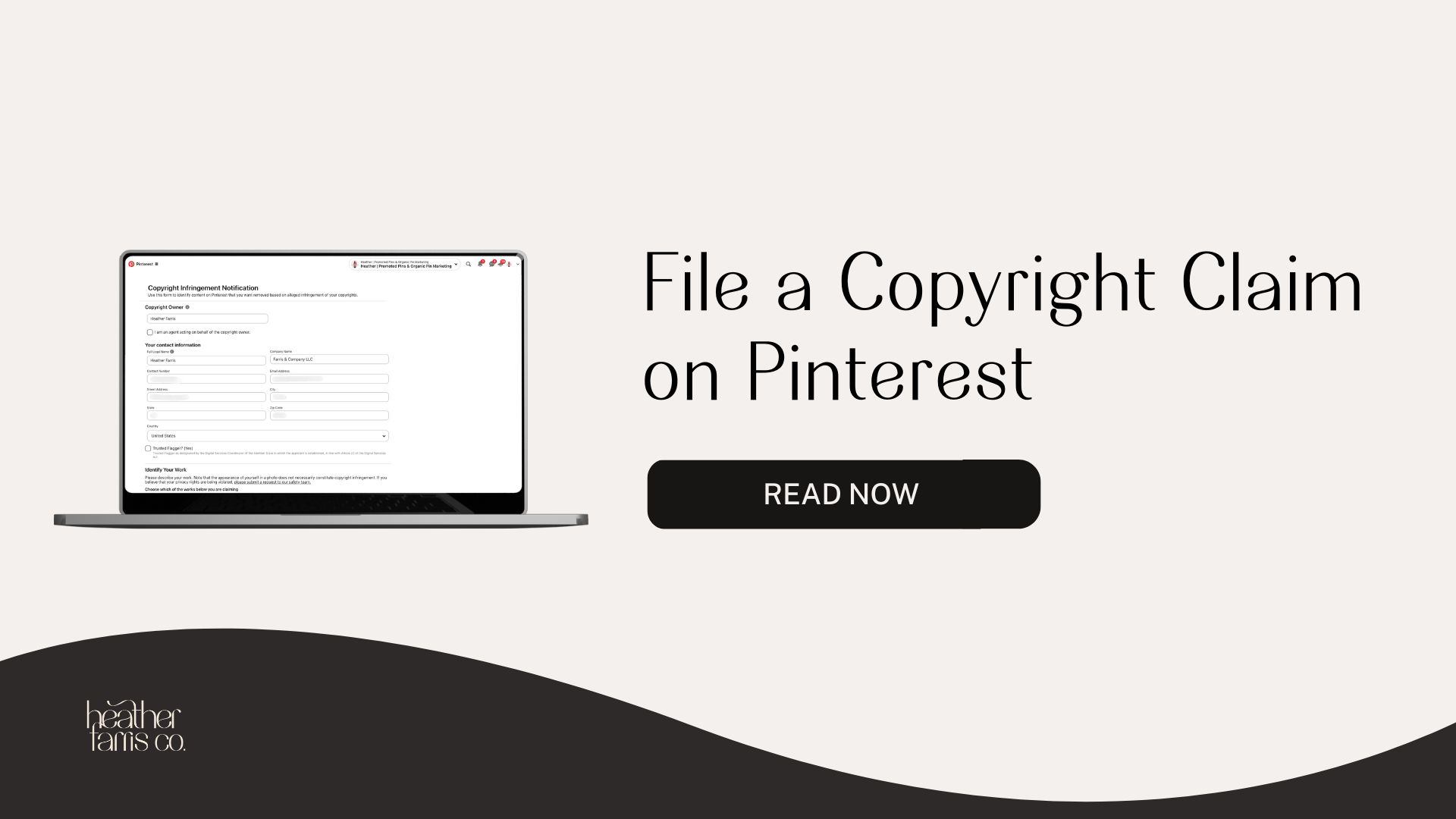Heather is a seasoned
Pinterest marketing expert & educator using the platform since you could reach the bottom of the feed - 2010.
About Heather Farris >
How to Use Pinterest Ads For Digital Products on Etsy
October 25, 2024
Are you a digital product seller looking to run Pinterest ads for your Etsy Store? Well, this post is for you. I am walking you behind the scenes this week on how to set up Pinterest ads for digital products on Etsy, and your overall campaign strategy to find and attract brand-new buyers to your Etsy Store.
How do I promote my Etsy digital products on Pinterest?
First, it’s vital to set up proper tracking for your Etsy store. That way, you have everything that you need in place before you start your Pinterest ads for digital products on Etsy. If you can’t see the data from all angles with how things are performing, you’re shooting in the dark.
Google Analytics 4 setup for Etsy
To start, what I want you to do is go to your Google Analytics. You will be using Google Analytics 4 because Universal Analytics was retired recently..
So, you are going to go to your Google Analytics 4. I am going to assume you already have it set up. This post is not for that. You will need to find another tutorial if you do not have Google Analytics 4 set up.
Once you are in your dashboard, go into that Admin tab at the bottom. Then you will go to Data Streams in the middle, and open that up.
You need your measurement ID right there, and you’re going to put that into your Etsy Shop. Copy that and head over to your store.
RELATED: Pinterest Analytics: A Simple Guide to Read & Analyze Your Data
How to track Etsy sales from Pinterest ads
Next we will dive right into the shop manager over on Etsy. Once you are inside your Etsy dashboard, and we already have the Google Analytics measurement ID copied.
In your Etsy dashboard, go to Settings > Options > Web Analytics. Go and paste your property ID here, and save that.
Now, you can do one of two things: set up an Etsy discount link, or use a UTM code in your analytics.
You can set up a special link with a sale or a discount for your Etsy store, and drive your ads towards that. Then once you see how many uses it has and you know you are only sending traffic from this one place from Pinterest to that link.
Then you can either track your sales that way or, if you would like to see them inside of all your analytics, then you will want to set up a UTM code. This is the best way to link Pinterest ads for digital products on Etsy into your analytics.
RELATED: Pinterest for E-Commerce – 3 Tactics for Etsy Store Owners to Increase Sales
How to set up UTM codes with Pinterest ads for digital products on Etsy?
Let us talk briefly about setting up UTM codes because if you have an Etsy store, I’m going to assume you already know how to set up your sale links. But UTM codes are a whole different thing, but much more complete in the big picture of your analytics.
There are two ways to create free UTM codes:
- with my Pinterest System spreadsheet (easiest!)
- using Google Analytics Dev tools (trickiest)
I’ll show you all three ways But to do all three, we need to grab our share links from our listings. On Etsy, go to the product listing you want to create a tracking link for and grab the URL.
My Pinterest system spreadsheet
I already have a UTM sheet set up, and it makes automatic UTM codes for me in My Pinterest System.
So we are going to paste that product link into the ‘Website URL’ column, and then we need to get our campaign information to finish building it out. To do that, we have to launch a Pinterest ad in drafts, which will give us that piece of code needed. Here’s how…
Pinterest ad campaign
From your Pinterest account dashboard, click the upper left menu, ‘Create Campaign’, and select ‘Consideration Campaign’. Scroll down a bit and give your campaign a name.
Be sure to select ‘Paused’ because we’re not needing this to go live just yet, will come back later to finish it. Change the budget to ‘Daily’ and put in say $15.00.
Navigate over to the Ad group, next link on the left side, and give it a name. I like naming my ad groups based on my targeting I’m focusing on: Keywords and Interests + Expanded Targeting is what I’d use.
Then, go to the ads section at the very bottom, and add a pin image for the ad. We do not care about the ad at this moment because it’s going to be launched on ‘Pause’ just so we can get the tracking details. You can worry about adding the images you want later.
You will add all of your targeting, demographics, and images later. So after you click ‘Publish’, you’ll be taken to the Ad Reporting screen where you can get the Consideration ID number for your ad. This is what we need for our UTM tracking.
Back in my Pinterest System spreadsheet, paste the number back into the ‘Campaign ID’ box. The source will be Pinterest, the medium will be ‘cpc’ for cost per click. Then let the formula fill in the UTM link generator column, and there you go.
Google Analytics Dev tools
Now, there is another place where you can make UTM codes for free. You don’t have to purchase my Pinterest System to get an automatic UTM code builder. You can go to Google Analytics Dev Tools.
Click ‘Campaign URL Builder’. Then just fill in all of the same information that we already gathered previously to build your UTM code. Copy the UTM link it creates to save for later.
How to find campaigns in GA4
How do you find your information when you are in Google Analytics? Under ‘Reporting’, you’ll go to ‘Acquisition’ and ‘Traffic Acquisition’. Then down in the chat, toggle the ‘Channel Group’ to ‘Session Campaign’. Then you’ll see all the campaigns you’ve created as populated.
These are examples of campaigns I’ve tracked from emails I’ve sent, shop listings in my Shopify store, Facebook ads that I was running, etc. So you can see that these campaigns are varied. Your Etsy UTM campaign will show up here, and it will be the name of your campaign.
That’s it. That’s how you find it here once you get that far.
RELATED: How to Sell Digital Products to Your Email List
Campaign strategy with Pinterest ads for digital products on Etsy
Because Etsy is a third-party platform and we don’t have the ability to track conversion events, we do have to set up a Pinterest consideration campaign. When I was walking you through the actual UTM code setup earlier, we set up this campaign on pause so we could get the campaign ID.
Now, I want you to go in and click ‘Edit’ on the same campaign, and we’re going to set this again as if we were setting it up strategically.
RELATED: How to Create a Pinterest Conversion Campaign (Step by Step Tutorial)
Daily budget ad spending
We have the campaign name, the type, and everything already set to go. We set it before at $15 a day. Anything less than $10 is going to be difficult to drive conversions. You want to do a higher budget than $10 a day.
I generally will not set a budget of less than $20 per day for conversion campaigns. But because this is a consideration campaign billed per click, you don’t pay Pinterest for the ad until a pinner clicks on it.
In conversion campaigns, conversely, you get billed per 1000 views of your ad. So, in consideration, we can stomach a slightly lower daily budget simply because of the way it’s billed and the auction.
I wouldn’t suggest anything less than $10 per day. You’re just not going to see as many sales ongoing if you have a really low budget.
RELATED: Pinterest Search Ads: How to Test a Pinterest Advertising Strategy w/o Spending a Fortune
Campaign Set Up
Audience consideration
When it comes to funnels, there is content for awareness, consideration, and purchase. Awareness is top-of-funnel, consideration is middle-of-funnel, and purchase is the bottom-of-funnel.
We’re going to treat this as a cold top-of-funnel campaign with interest and keywords to find new audiences for our ads. Now, a general rule of thumb is to do 3 to 4 million people in your audience for every $100 you spend.
When you look at the right side of your ‘Ad Group Details’ screen, you can see the potential audience size. When you start, the targeting will be clearly over that goal. So, we will play with our interests to see how we can define those down more.
Targeting details + interests
Next thing, Under your ‘Targeting details’, click the ‘Interests and Keywords’ dropdown. The checkbox ‘Enable Performance+ targeting’ means that it will reach people searching for topics relevant to your ads.
For example, in my case, Pinterest may serve my ads to people looking for Instagram templates for Canva because they are looking for Canva templates. And if they’re looking for Instagram, they may also be interested in my Pinterest templates. That’s what that additional targeting means.
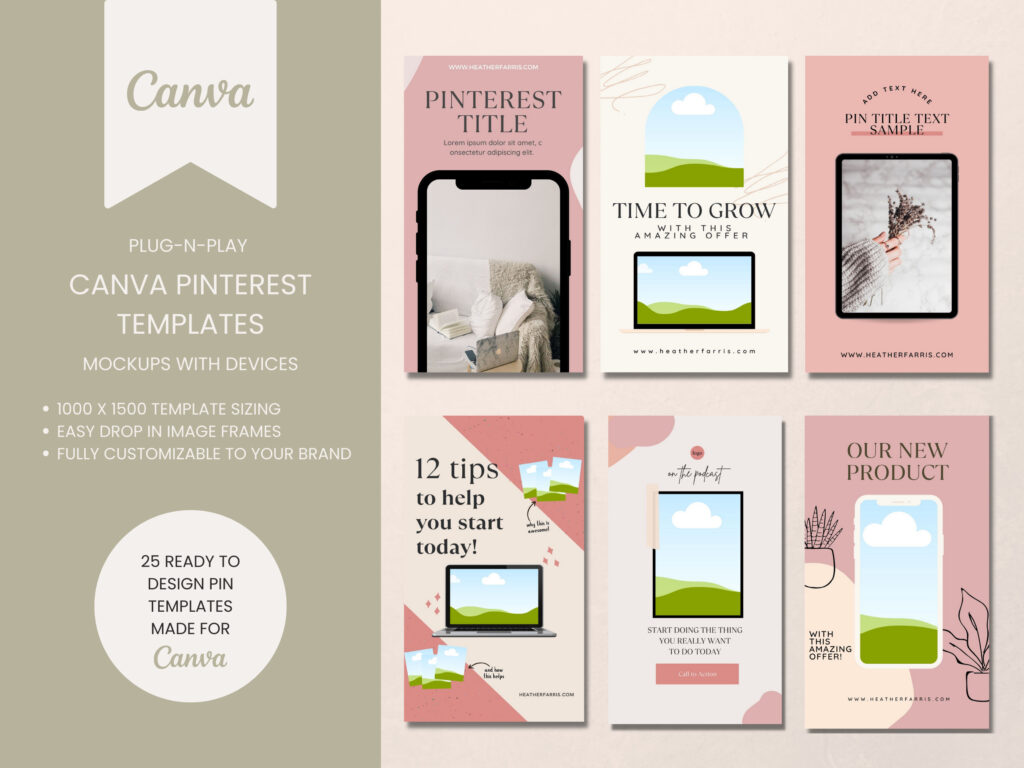
Pinterest Pin Templates for Digital Products Mega Pack
These Pinterest templates for Canva are fully editable and can be branded to your businesses with a click of a button. This set of templates are designed to promote digital products on Pinterest.
Take your Pinterest marketing strategy to the next level by consistently creating fresh pins, showing up for your audience and being there when they search for you.
Now, in the interest tab, I like to go in and select items that are a lower level interest that are more specific to my target audience. Everything above a level one interest will show on your reporting.
Everything below level one will not be broken down in your reporting metrics. But it’s very important for ensuring that you select the right interests and understand what interests are driving sales. Or you won’t get the proper information on the back end with your Pinterest ads for digital products on Etsy.
In each interest category, we don’t want to choose all of them. We want to choose the ones that are the most appropriate. So uncheck the boxes and get rid of the lower level specific interests that don’t apply to your targeting. Then, you can see how that reflects in our overall campaign metrics.
Adding keywords
Now, we want to click ‘Add Keywords’. In the keyword section, you have several options to find keywords for your Pinterest ads. The first way is inside the ‘Extend your reach’ box, search for related keywords, box. Another way that you can find keywords is on Pinterest, right inside the search bar for popular searches.
I’m not going to go in-depth on how to find keywords today. You can watch my Pinterest SEO YouTube video if you’re interested in that.
Now, you want to add campaign keywords that are relevant to the topic at hand. I have also added keywords that previously worked for me in the past. You can paste in a list of any keywords into the left box at any time. They don’t have to be searched on the right to add.
PRO TIP: You can go back and add keywords to campaigns after they’re running. After you start seeing the targeting attributions of your audience conversions, leads or checkouts, go back and add those keywords back into the same campaign if they’re not there already.
RELATED: A Step-by-Step Guide to Pinterest Keyword Strategy to Boost Traffic
Keyword strategy
Now, one of the most frequently asked questions I get is “How many keywords I should add to my campaign?” When you first start adding keywords, Pinterest says to use a minimum of 25. I like to add anywhere from 100 to 150. Pinterest reps advice will vary, but my most recent one told me 75 to 150. Somewhere in that range will be perfectly fine.
Now, we are going with a broad keyword strategy here, meaning that my keywords are without quotes, no brackets, no negative match, no phrase match, or anything. You can see at the bottom of the box, there’s indicators you can specify your keyword matching by. But we’re going to broad match keywords.
RELATED: 6 Places to Use Keywords to Optimize Your Pinterest Profile
Demographics
Moving on from your targeting, we are going to set up your demographics. For me specifically, I do not market to men specifically. If you’re a male, hello and welcome. But I don’t advertise to you or spend my advertising dollars on men because men on Pinterest are so much fewer.
In my audience insights, 26% of my audience on Pinterest are men, but 72% are female or unspecified. So that’s where I will spend most of my money.
Now, when it comes to ages, I don’t like to predefine them right away, but I also don’t particularly like promoting to anyone over 55. Often, what I do, and how I teach it to other marketers, someone over 55-ish has a much more lengthy time needing help. Which isn’t the best use of my time for what I have and the money I’ve allotted.
For your audience, you have to make some decisions here. You do not want to stranglehold your demographics from the beginning, so don’t get too well defined here. Gender and age is the thing I want you to touch right away, depending on your business and who’s going to be in your audience grouping. Don’t touch the other settings from the start.
Now, if you are in another country and not in the US, and you want to promote here, then you need to make sure you add your location and your target location.
Under ‘Placement and Tracking’, don’t touch anything in that section.
Optimization and delivery
There are two distinct optimization methods here. For any cold campaigns, I would suggest leaving it selected on ‘Pin clicks’. However, if you are looking for people who are more likely to click off of Pinterest and go to your website, then you might choose ‘Outbound clicks’. Just know that your audience sizing is probably going to be fewer with the latter.
For bidding, we’re going to leave it as ‘Performance’ recommended. Don’t touch this because most people don’t know how much they pay per click. I have campaign data to back this up as the best option.
‘Ad group status’ is obviously active once you want it live. Then you’ll choose your pin images for the ad.
How to create pins for digital products for your ads on Pinterest
Let’s talk briefly about pin creation and creating pins for your ad’s imagery and what that should look like as far as your campaign goes.
So, I went and created three different images for this example: two are Christmas-related gift guides set of templates pin image, and an aesthetic Pinterest Template image as well.
Now, a couple of things that you should know. Whatever your Etsy sale is or promotion, put that somewhere on the pin. You also want to use your main keyword for that Pinterest pin as part of your text overlay. Now, we are talking about digital products here, so showcase your Etsy products as much as possible, just like physical products.
Search your ad keywords right in Pinterest to see what pins show up. From the top search results, how can your branding or pin design stand out differently and better? You can do that before you create Pinterest pins, or know better what to use from your current content.
I don’t like sticking in and being the same as everyone else, so I try to stand out with my own branding. If you want to get more strategic with it, you can do that.
RELATED: How to Make Pins For Digital Products: Create Product Pins on Pinterest
Adding pins to your campaigns
There are two different ways that you can add images to your campaign. You can have them pull in from existing pins you want to promote, or manually upload them.
To find existing pins, you need want to find the parameter that Pinterest has assigned to it. To do that, you’re going to go to the actual Pinterest pin and just pull these numbers in from the URL.
Under ‘Add Pin to promote’, click go to ‘Select Pin’. In the search bar that pops up, you are going to paste in the URL parameter you want, and it’s going to pull that image up. Click on your pin and it will pull it into your ad campaign.
The other way is to upload the pins directly into your ads manager. You would click ‘Create ad’ and go through the regular pin builder to get the pin published first.
PRO TIP: one of the best practices if you use the pin builder inside of the ad campaign, I always recommend keeping the ‘Ad-only Pin’ toggle option OFF. If you publish a new pin as only an ad pin, once your campaign is over or turned off, that pin will no longer show up organically. You’ll want to let these pins live on even after a campaign to keep accumulating views and engagement.
Click ‘Add Pins’, and you’ll see everything in the whole listing. On each ad pin, you need to change the URL or we can’t track them how we intend. We actually want the UTM parameter that we set up earlier, finishing off with one of the most important things.
So, grab the correct UTM parameter you set up from before for each. Paste your UTM parameter into the URL box, and then you are ready to launch. Last thing, make sure nothing is showing as ‘Paused’. Check they’re all on active, and you will start to see that campaign run within 24 hours.
RELATED: Schedule Your Pins for FREE using the Native Pinterest Scheduler
Final thoughts on how to use Pinterest ads for digital products on Etsy
That’s it. That’s how to use Pinterest ads for digital products on Etsy, and eventually, you should be able to see your data inside of your Google Analytics because you connected the property to Etsy through your UTM links.
Now that you know how to set up your Pinterest ads to promote your Etsy store to new buyers, you may need to know how to set up an overall organic Pinterest strategy. Head on over and watch the complete Etsy Pinterest marketing strategy video, and I will see you over there.
Pin it for later
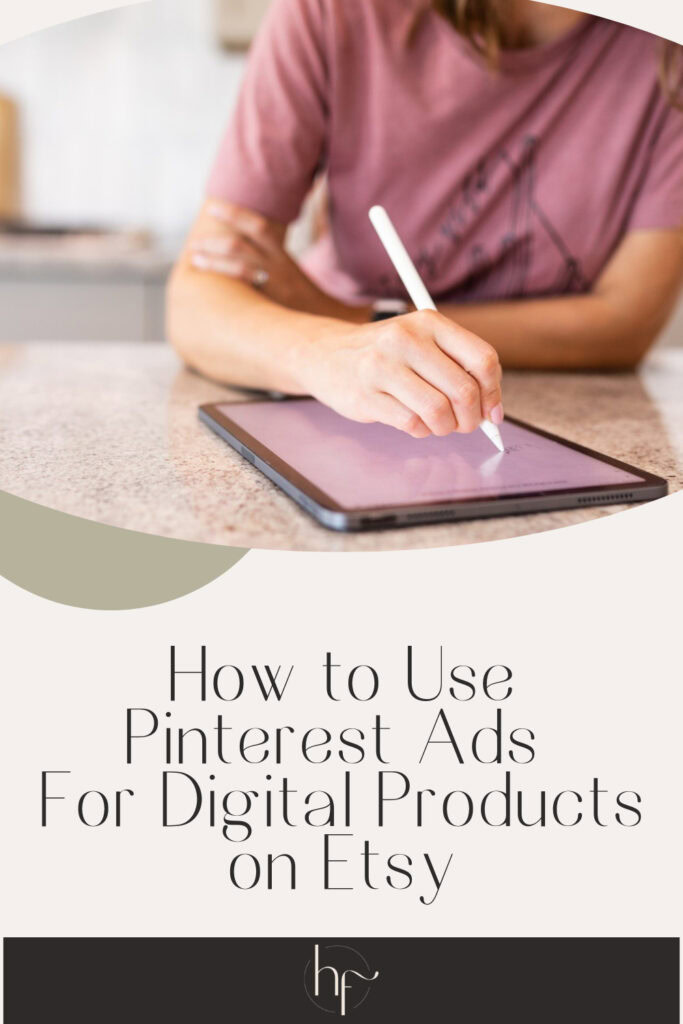
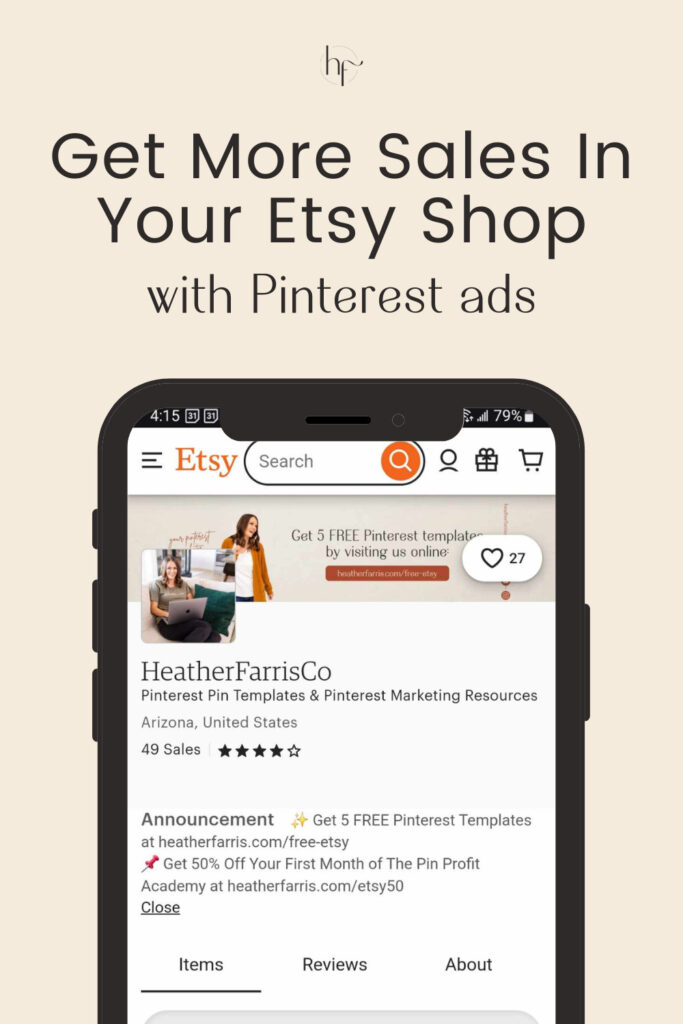
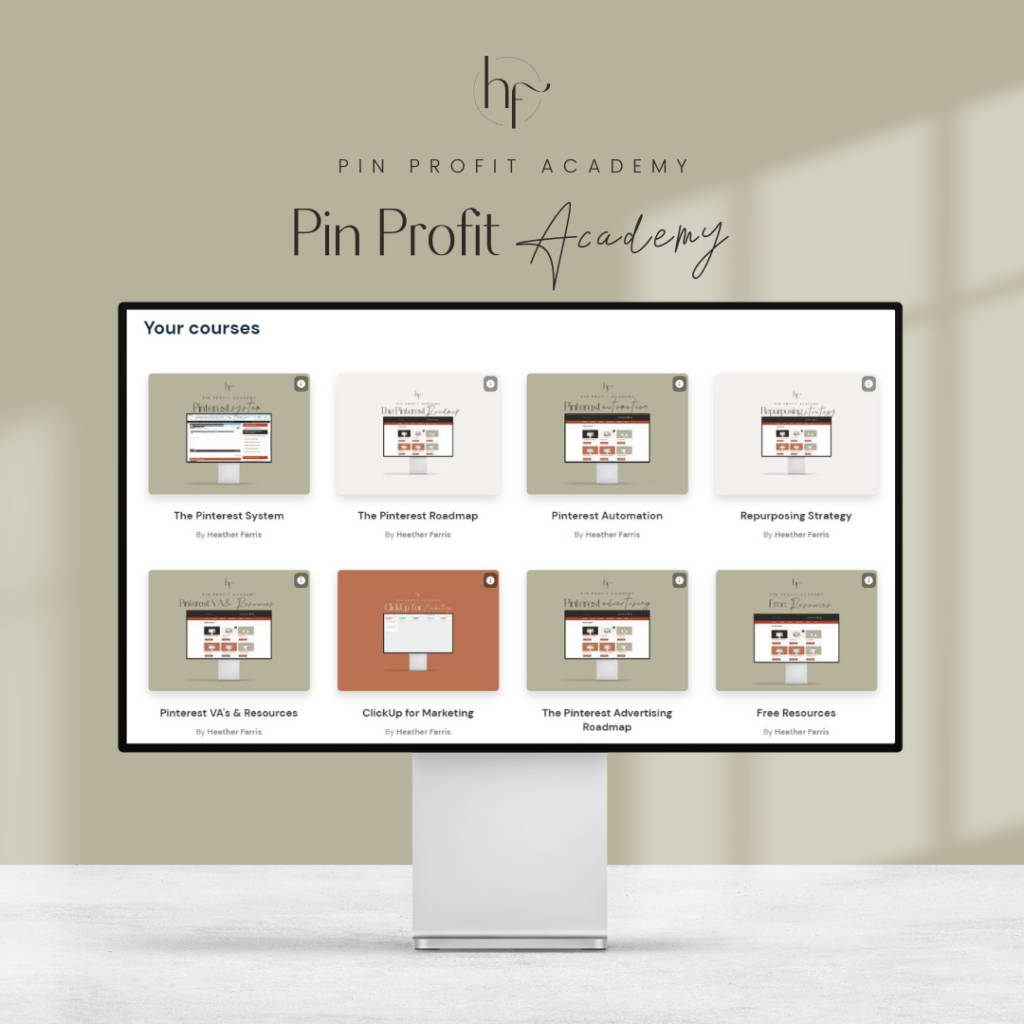
Pin Profit Academy
Marketing can be difficult and trying to figure it out on your own, especially with Pinterest, can be overwhelming.
I will show you how to double your traffic and sales without spending another minute on social media!
PPA is the only comprehensive membership program & community for creating, marketing & selling your products & services using Pinterest.
Heather Farris went to school for accounting and worked for years in banking and finance. After finding all of that entirely too boring she started her first blog in her basement in August of 2016. She has started 3 blogs in the marketing, motherhood and travel niches and used Pinterest to grow them all. She quickly became the go-to Pinterest strategist in her peer circles and has been implementing strategies, driving traffic and sales through organic and paid tactics for her clients. On this blog and her YouTube channel, as a renowned Pinterest marketing expert, she educates the public about clear and transparent marketing strategies to help them to grow on Pinterest and in other places online as a renowned Pinterest marketing expert.
